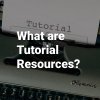
Introduction to Tutorial Resources on Learnful
Lesson by Help@Learnful · 5 years ago ·
Instructional Summary
An introduction and guide to creating Tutorial Resources on Learnful.Content Blocks
At it's most basic form, a Tutorial Page is a webpage that is comprised of a number of Content Blocks. There are a couple of things that make Tutorial Pages more useful that a webpage, these include:
- Shareable URL
- Embeddable Resource
- Author Metadata
- Creative Commons Licensing
- Immediately sharable in Learnful
Let's discuss each of these in detail.
Content Blocks and Authoring a Tutorial Page
First let's consider how a Tutorial Page is authored. You can start creating your own Tutorial by visiting the Create Resources section on Learnful and selecting Create Tutorial.
On the Tutorial Builder page you will notice the Content Blocks region (screenshot below). This is where we start adding block of varying types to build our page.
Currently there are five types of Content Blocks that we can use to build our page, these include:
- Text Block
- Image Block
- Photo Grid
- Embed Code
- Interactive Content
- Two-Column
We can use any combination of blocks in any order to create our tutorials. Certain blocks have additional settings, like background colour and width of the content within the block. You will also notice that you can re-order the content blocks by dragging-and-dropping them. Lastly, you can also edit, remove, and duplicate blocks as you build your page.
Let's take a look at the most widely used block, the Text Block:
Share-able URL (Launch Page)
Another feature that should make Tutorial Pages useful to you is the Share-able URL or Launch page. When viewing a Tutorial, you will notice a button that reads "Launch Tutorial".
Clicking on the "Launch Tutorial" button will take you to the Tutorial's share-able URL. This is the URL you would share with you students.
The Content Blocks that make up the page's content will be displayed in a stylized manner on this page. The page will also display metadata about the page, including the author's information, licensing, and links to share and embed the tutorial page in your courses or websites.
Tutorial Metadata Region
You will also notice that many of the important details about a Tutorial will be displayed in the "About this Tutorial" section found underneath the tutorial's content.
The information in this section provides links to the author of the tutorial, licensing information, last updated date, etc. This information is important for other authors and instructors - they can easily attribute your work and make a decision on using your tutorial based on the information and licensing you have provided.
The default license for a Tutorial Page is the Creative Commons Attribution License (CC-BY). This can be changed in the Tutorial Editor page.
Sharing Tutorials
The last section on a Tutorial Page is the Share section. In this section, the use will be presented with different methods to share and re-use your Tutorial page in their courses or websites.
There are currently four ways to share a Tutorial:
Share the URL: The simplest way to share a Tutorial is to provide a link the Launch page the Tutorial. Copy and paste the link provided in this field to link to the Tutorial's launch page.
Share in Class: If you have a course shell in an LMS, such as Google Classroom, you can quickly include this tutorial in your course by selecting the appropriate LMS. Currently only Google Classroom is available for this type of sharing.
Share on Social Networks: You can quickly create a post, tweet, or email to share this tutorial in your social circles.
Embed the Tutorial: You can copy/paste the embed code provided here into your course or website to include a stylized "card" that links to this tutorial. A preview of what that card will look like is provided here as well.
Summary
Tutorial Pages allow authors to create, share, and embed single-page learning content. These pages are constructed by creating and arranging blocks of content. There are five different types of blocks that can be created, allowing authors to create dynamic pages. Authors can also provide metadata about their tutorial, including licensing, to make their tutorial easier to adopt by other authors. Each tutorial can also be shared in a number of ways, including linking to the Tutorial's launch page, sharing the tutorial in your LMS with one click, sharing the tutorial on social networks, and embedding a stylized card that links to the tutorial.
If you have any questions or comments about Tutorials on Learnful, please do not hesitate to contact help@learnful.ca.
Collaborators
License
Introduction to Tutorial Resources on Learnful by Help@Learnful is licensed under a Creative Commons Attribution License (CC BY), except where otherwise noted.


Comments
Be the first to comment!